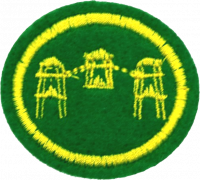AY Honor Rustic Construction Answer Key
Skill Level
2
Year
2012
Version
10.01.2026
Approval authority
South American Division
1
2
For tips and instruction see Knot Tying.
3
3a
3b
3c
3d
4
5
6
The North American Division has an honor specifically dedicated to lashing. These two honors can easily be done togethers.
6a
Square lashing is a type of lashing knot used to bind poles together. Large structures can be built with a combination of square and diagonal lashing, with square lashing generally used on load bearing members and diagonal lashing usually applied to cross bracing. If any gap exists between the poles then diagonal lashing should be used.
Square lashing steps (see image at right);
- Begin with a timber hitch on the vertical pole beneath the horizontal pole and tuck the loose end under the wrapping.
- Wrap in a square fashion about three times around the poles.
- Frap between the poles two or three times, pulling often to work the joint as tight as possible.
- Tie two half hitches around the horizontal pole
- Cinch the half hitches into a clove hitch, an additional clove hitch may be added if desired.
When the turns are taken around the vertical pole they should be inside the previous turns. The ones around the cross pole should be on the outside of the previous turns. This makes sure that the turns remain parallel and hence the maximum contact between the rope and wood is maintained.
Strength is improved if care is taken to lay the rope wraps and fraps in parallel with a minimum of crossing.
An alternative method is known as the Japanese square lashing. The Japanese square lashing is similar to the standard square lashing in appearance, but in fact is much faster and easier to use. One drawback to consider is that it is difficult to estimate how much rope is needed, which can lead to needlessly long working ends.
- Begin by placing the middle of the rope under the bottom pole
- Lay both ends over the top pole, and cross under the bottom pole. Do this about three times. Take care to keep the wrappings as tight as possible.
- After the last wrap, cross the ropes again over the bottom pole and frap around the wrappings. Do this enough times (at least 3) to finish with a square knot.
A properly executed lashing is very strong and will last as long as the twine or rope maintains its integrity. A lashing stick can be used to safely tighten the joint.
6b
Diagonal lashing is a type of lashing used to bind spars or poles together, to prevent racking. It is usually applied to cross-bracing where the poles do not initially touch, but may by used on any poles that cross each other at a 45° to 90° angle. Large, semipermanent structures may be built with a combination of square lashing, which is stronger, and diagonal lashing.
Bailing twine has sufficient strength for some lashing applications but rope should be used for joining larger poles and where supporting people sized weights.
Diagonal lashing steps (see image at right);
- Begin with a timber hitch around the juncture of the two poles.
- Make three turns in each direction - tightening steadily as you go.
- Make two frapping turns, tightening the joint as much a possible.
- To end, make two half hitches
- Cinch the half hitches into a clove hitch
A lashing stick can be used to safely tighten the joint. Strength will be improved if the first turn is 90° to the timber hitch and if care is taken to lay the rope turns parallel with no crossings.
6c
6d
6e
7
7a
7b
7c
7d
7e
7f
7g
Observation





